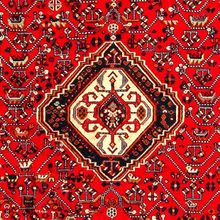Qashqai Rug
| Qashqai Rug | |
|---|---|
 Design of Qashqai Rug (Rugman) | |
| General information | |
| Name | Qashqai Rug |
| Original name | قالی قشقایی |
| Alternative name(s) | Qashqai Carpet |
| Origin | |
| Category | Tribal, Village |
| Technical information | |
| Common designs | Herati , Afshan, Boteh, Geometric |
| Common colors | Crimson, Blue, Navy Blue, Green, Yellow, Brown, White, Cream |
| Dyeing method | Natural, Synthetic |
| Pile material | Wool |
| Foundation material | Cotton, Wool |
| Knot type | Asymmetrical (Persian), Symmetrical (Turkish) |
Qashqai carpet or Qashqai rug is a tribal, village rug that is woven in Qashqai tribe living in southwestern Iran along the Zagros Mountains mostly in the Fars and Khuzestan Provinces. These rugs are employed symmetrical and Asymmetrical knots with cotton, wool foundation and a wool pile. The designs of these rugs are Herati, Afshan, Boteh and Geometric, and the colors are Crimson, Blue, Navy Blue, Green, Yellow, Brown, White, Cream.
History
The Qashqai are a large and important tribe living in southwestern Iran along the Zagros Mountains mostly in the Fars and Khuzestan Provinces. Much of the Qashqai tribe has settled in cities, towns, and villages, though some still live as seminomads, moving in summer to the highlands and returning in winter to the valleys because of the climate. The Qashqai raise farm animals for a living.
In the beginning of the second millennium, the Qashqai tribe moved from northern Persia to the Fars region in the south. The tribe has spoken a Turkic dialect for centuries, up to the present day. The Qashqai tribe is divided by location into many subtribes, notably the Baseri, Bolli, Darreh-Shuri, Farsimadan, Kashkuli, Safi-Khani, Shekarlu, and Shishbuluki, all of whom make Qashqai rugs. The weaving subtribes that are most well known are the Kashkuli and Shekarlu, who have mostly settled in towns and villages such as Farashid, Firuzabad, and Kazerun, in the Fars Province.
Qashqai rugs are known in the antique market from the mid-nineteenth century. The foundations are made of wool or, at times, a mixture of wool and goat hair. Sheep wool is used for the pile. The Persian (asymmetric) knot is universally employed. The Qashqais made pile and flatwoven rugs for personal daily use, such as transport bags, shepherd bags, Namakdan (salt) bags, Paneer (cheese) bags, and grain storage bags, among others. Rug formats can range from five feet by three feet to fourteen feet by eight feet gallery sizes. Some pile rugs have a charming flatwoven Kilim finish on both ends.
Some Qashqai rugs were finely woven with a silk weft during the nineteenth century. Also, young Qashqai women customarily wove Jahaz rugs before marriage. The jahaz rug is part of the bride's dowry, symbolizing the new family life ahead. These two Qashqai rug types are rare and are in demand by collectors in the antique market.
In the nineteenth and twentieth centuries, the Qashqai standard of living was greatly improved by weaving rugs and carpets. The formats range from tribal bags to small room-size rugs. Qashqai weavings are generally produced from medium to fine in grade quality.
Qashqai rugs have geometric designs and often have mostly a center medallion and medallion quadrants in the corners of the field. At times, two or three medallions decorate the background. The design motifs feature small flowers, leaves, tribal ornaments, animals, and birds strongly reminiscent of weavings from Asia Minor. Qashqai weavers also replicated famous traditional Persian Boteh (paisley), Herati (fish), and Minakhani (rosette-linked trellis) designs in the background and medallions of rugs. Occasionally, the Turkmen Gul (flower) surrounded with Hook motifs was used as the medallion and in the corners of the field. Another Qashqai field design has horizontal, vertical, or diagonal stripes featuring flowers and leaves. Qashqai weavers also made fine rugs with a silk weft in the famous Persepolis historical design.
One particularly famous rug style by the Kashkuli features a Millefleurs geometric design. This pattern was inspired by Mughal-period KASHMIR designs. This allover style has a Mihrab (prayer arch) that is supported by a cypress tree woven on each side of the field. The Shekarlu Qashqai design characteristics have dense allover patterns. The rugs feature tribal elements, leaves, Shrub motifs, and ornaments edged by Hook motifs. Animals and birds are also included in some pieces. The border designs mostly have repeated elements of shrubs with lozenge-shaped Turkmen guls. The Shekarlu field coloration has blues, ivory, or reds. These hues are interchange-able with the main border.
Another design haracteristic woven by the Qashqai features a lion in four corners of the background. Occasionally, one large lion dominates the entire field of the rug. The lion symbolizes power and the proud nature of the Qashqai tribe. In the past, the Qashqai were known to be strong fighters and protectors of their region.
The field coloration used by the Qashqai tribe is reds, ivory, blues, and greens. In addition, different shades of brown, cinnamon, and gold are used for the borders, medallion, corners, flower heads, and design elements. Dark brown or black is utilized for the design outlines.
During the carpet market boom of the last quarter of the twentieth century, Qashqai weavers produced finely woven rugs, some with a silk foundation and a silk pile. Most of these rugs were commissioned by dealers for the domestic and foreign export markets. Qashqai pile rugs, flatweaves, and tribal items can be found in the Shiraz Vakily bazaar.[1]
See also
| Search for Qashqai Rug on Wikipedia. |
References
- ↑ Moheban, 2015, 459-461
Bibliography
- Abraham Levi Moheban. 2015. The Encyclopedia of Antique Carpets: Twenty-Five Centuries of Weaving. NewYork: Princeton Architectural Press.